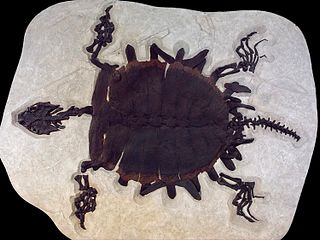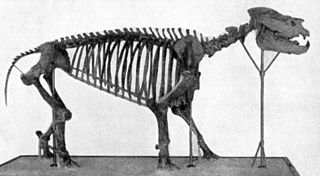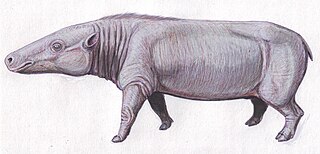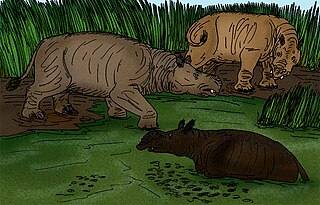
Equidae is the taxonomic family of horses and related animals, including the extant horses, asses, and zebras, and many other species known only from fossils. The family evolved around 50 million years ago from a small, multi-toed ungulate into larger, single-toed animals. All extant species are in the genus Equus, which originated in North America. Equidae belongs to the order Perissodactyla, which includes the extant tapirs and rhinoceros, and several extinct families.

Perissodactyla is an order of ungulates. The order includes about 17 living species divided into three families: Equidae, Rhinocerotidae (rhinoceroses), and Tapiridae (tapirs). They typically have reduced the weight-bearing toes to three or one of the five original toes, though tapirs retain four toes on their front feet. The nonweight-bearing toes are either present, absent, vestigial, or positioned posteriorly. By contrast, artiodactyls bear most of their weight equally on four or two of the five toes: their third and fourth toes. Another difference between the two is that odd-toed ungulates digest plant cellulose in their intestines, rather than in one or more stomach chambers as even-toed ungulates, with the exception of Suina, do.

Ungulates are members of the diverse clade Euungulata which primarily consists of large mammals with hooves. Once part of the clade "Ungulata" along with the clade Paenungulata, "Ungulata" has since been determined to be a polyphyletic and thereby invalid clade based on molecular data. As a result, true ungulates had since been reclassified to the newer clade Euungulata in 2001 within the clade Laurasiatheria while Paenungulata has been reclassified to a distant clade Afrotheria. Living ungulates are divided into two orders: Perissodactyla including equines, rhinoceroses, and tapirs; and Artiodactyla including cattle, antelope, pigs, giraffes, camels, sheep, deer, and hippopotamuses, among others. Cetaceans such as whales, dolphins, and porpoises are also classified as artiodactyls, although they do not have hooves. Most terrestrial ungulates use the hoofed tips of their toes to support their body weight while standing or moving. Two other orders of ungulates, Notoungulata and Litopterna, both native to South America, became extinct at the end of the Pleistocene, around 12,000 years ago.

Artiodactyls are mammals belonging to the order Artiodactyla. Typically, they are ungulates which bear weight equally on two of their five toes: the third and fourth, often in the form of a hoof. The other three toes are either present, absent, vestigial, or pointing posteriorly. By contrast, most perissodactyls bear weight on an odd number of the five toes. Another difference between the two is that many artiodactyls digest plant cellulose in one or more stomach chambers rather than in their intestine as perissodactyls do. The advent of molecular biology, along with new fossil discoveries, found that cetaceans fall within this taxonomic branch, being most closely related to hippopotamuses. Some modern taxonomists thus apply the name Cetartiodactyla to this group, while others opt to include cetaceans within the existing name of Artiodactyla. Some researchers use "even-toed ungulates" to exclude cetaceans and only include terrestrial artiodactyls, making the term paraphyletic in nature.

Camelids are members of the biological family Camelidae, the only currently living family in the suborder Tylopoda. The seven extant members of this group are: dromedary camels, Bactrian camels, wild Bactrian camels, llamas, alpacas, vicuñas, and guanacos. Camelids are even-toed ungulates classified in the order Artiodactyla, along with species including whales, pigs, deer, cattle, and antelopes.

Mesonychia is an extinct taxon of small- to large-sized carnivorous ungulates related to artiodactyls. Mesonychians first appeared in the early Paleocene, went into a sharp decline at the end of the Eocene, and died out entirely when the last genus, Mongolestes, became extinct in the early Oligocene. In Asia, the record of their history suggests they grew gradually larger and more predatory over time, then shifted to scavenging and bone-crushing lifestyles before the group became extinct.

Axestemys is an extinct genus of softshell turtle that lived from the Late Cretaceous to the Eocene in western North America and Europe.

Presbyornis is an extinct genus of anseriform bird. It contains two unequivocally accepted species; the well-known P. pervetus and the much lesser-known P. isoni. P. pervetus was approximately the size and shape of a goose, but with longer legs; P. isoni, known from a few bones, was much larger, more than swan-sized. Other fossils, more doubtfully assigned to this genus, are also known.

Merycoidodon is an extinct genus of herbivorous artiodactyl of the family Merycoidodontidae, more popularly known by the name Oreodon. It was endemic to North America during the Middle Eocene to Middle Miocene existing for approximately 30 million years.

Eotitanops is an extinct genus of brontothere native to North America and Asia.

Metamynodon is an extinct genus of amynodont that lived in North America and Asia from the late Eocene until early Oligocene, although the questionable inclusion of M. mckinneyi could extend their range to the Middle Eocene. The various species were large, displaying a suit of semiaquatic adaptations more similar to those of the modern hippopotamus, despite their closer affinities with rhinoceroses.

Trigonias is an extinct genus of rhinocerotid from the late Eocene (Chadronian) some 35 million years ago of North America. Trigonias was about 2.1 metres long and, despite lacking horns, looked a lot like modern rhinos. Its front legs had five toes, the fifth of which was vestigial.

Diacodexis is an extinct genus of small herbivorous mammals belonging to the family Diacodexeidae that lived in North America, Europe and Pakistan from 55.4 mya to 46.2 mya and existing for approximately 9.2 million years.

Protylopus is an extinct genus of camel that lived during middle to late Eocene some 50-40 million years ago in North America.

Oxyaena is an extinct genus of placental mammals from extinct subfamily Oxyaeninae within extinct family Oxyaenidae, that lived in Europe, Asia and North America during the early Eocene.

Anthracotheriidae is a paraphyletic family of extinct, hippopotamus-like artiodactyl ungulates related to hippopotamuses and whales. The oldest genus, Elomeryx, first appeared during the middle Eocene in Asia. They thrived in Africa and Eurasia, with a few species ultimately entering North America during the Oligocene. They died out in Europe and Africa during the Miocene, possibly due to a combination of climatic changes and competition with other artiodactyls, including pigs and true hippopotamuses. The youngest genus, Merycopotamus, died out in Asia during the late Pliocene, possibly for the same reasons. The family is named after the first genus discovered, Anthracotherium, which means "coal beast", as the first fossils of it were found in Paleogene-aged coal beds in France. Fossil remains of the anthracothere genus were discovered by the Harvard University and Geological Survey of Pakistan joint research project (Y-GSP) in the well-dated middle and late Miocene deposits of the Pothohar Plateau in northern Pakistan.

The evolution of the horse, a mammal of the family Equidae, occurred over a geologic time scale of 50 million years, transforming the small, dog-sized, forest-dwelling Eohippus into the modern horse. Paleozoologists have been able to piece together a more complete outline of the evolutionary lineage of the modern horse than of any other animal. Much of this evolution took place in North America, where horses originated but became extinct about 10,000 years ago, before being reintroduced in the 15th century.

Amynodontidae is a family of extinct perissodactyls related to true rhinoceroses. They are commonly portrayed as semiaquatic hippo-like rhinos but this description only fits members of the Metamynodontini; other groups of amynodonts like the cadurcodontines had more typical ungulate proportions and convergently evolved a tapir-like proboscis.

Homogalax is an extinct genus of tapir-like odd-toed ungulate. It was described on the basis of several fossil finds from the northwest of the United States, whereby the majority of the remains come from the state of Wyoming. The finds date to the Lower Eocene between 56 and 48 million years ago. In general, Homogalax was very small, only reaching the weight of today's peccaries, with a maximum of 15 kg. Phylogenetic analysis suggests the genus to be a basal member of the clade that includes today's rhinoceros and tapirs. In contrast to these, Homogalax was adapted to fast locomotion.
Rhyphodon is an extinct genus of notoungulate, who lived from the Middle to the Late Eocene in what is today South America.





















